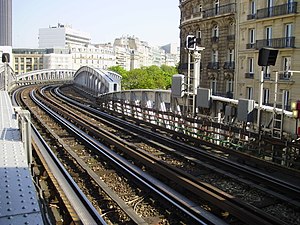Sèvres - Lecourbe (Paris Métro)
| Paris Métro station | |||||||||||
 |
|||||||||||
| Location |
15th arrondissement of Paris Île-de-France France |
||||||||||
| Coordinates | 48°50′44″N 2°18′34″E / 48.845634°N 2.309476°ECoordinates: 48°50′44″N 2°18′34″E / 48.845634°N 2.309476°E | ||||||||||
| Owned by | RATP | ||||||||||
| Operated by | RATP | ||||||||||
| Other information | |||||||||||
| Fare zone | 1 | ||||||||||
| History | |||||||||||
| Opened | 24 April 1906 | ||||||||||
| Services | |||||||||||
|
|||||||||||
| Location | |||||||||||
Sèvres—Lecourbe is an elevated station of the Paris Métro serving line 6 at the intersection of several streets including the Rue de Sèvres and the Rue Lecourbe in the 15th arrondissement.
This station is one of a small number of elevated Paris Métro stations. The tracks emerge from underground near the Pasteur station at Rue de Vaugirard and remain elevated through four more stations, crossing the Seine on Pont de Bir-Hakeim and descending underground west of the Seine near the Passy station. Visitors have excellent views of several notable landmarks from this station and its trains.
The station opened as part of the former Line 2 South on 24 April 1906, when it was extended from Passy to Place d'Italie. On 14 October 1907 Line 2 South was incorporated into Line 5. It was incorporated into line 6 on 12 October 1942.
The Rue de Sèvres was the old road, originally Roman to the village of Sèvres, now a suburb of Paris. The Rue Lecourbe was named after General Claude Lecourbe (1758–1815) who fought in the French Revolution and for Napoleon. Until 1907, the station was called Suffren after the Avenue de Suffren, named after Admiral Pierre André Suffren (1729–1788), who fought the British aggressively during the Seven Years' War (1754 and 1756–1763).
...
Wikipedia

